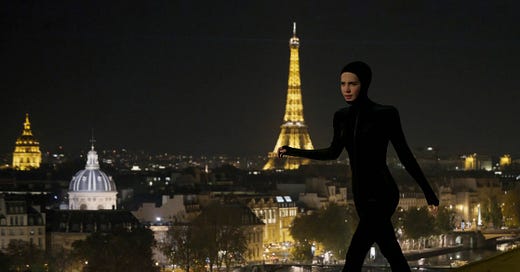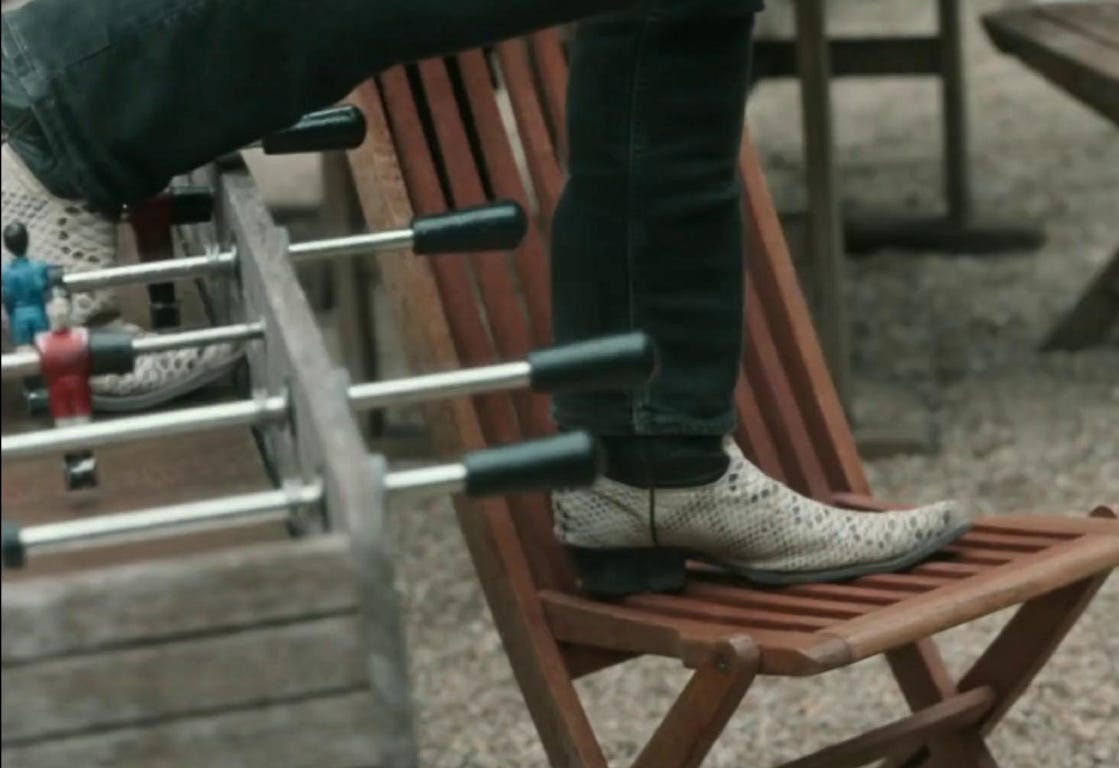Dear Reader,
A month or so ago, my wife and I sat down to watch TV. We were in that horrible and anxious entertainment netherworld called Between Shows, which usually involves me flipping through every single available title on every single available streaming service before turning off the television and going to bed early.
But on this particular night, we had a lead. She wanted to watch “The Staircase.” Some friends of one of her best friends are in it, and she wanted to see them. Based on a true story, like so many hit film properties, “The Staircase” is about a creepy husband (Colin Firth!) who maybe, probably murders his wife (Toni Collette!). True crime is not my favorite thing, and my wife—who, being a lovely and sensitive human, is more easily upset by what she watches than most people, much to the amusement of our kids—tends to avoid it like non-MAGA people avoid the plague. But we gave “The Staircase” a try. It opens with a tight shot of Firth lying in bed, as unsettling music plays. I don’t know what happens next, because we watched that one scene, all 20 seconds of it, and my wife made me turn it off. “I can’t watch this,” she said simply.
Flipping around HBOMAX, I found a then-current show called “Irma Vep.” The title was familiar—I thought, wrongly, that it was based on a stage play—and knowing nothing at all about it, we watched the first episode (which you can watch for free). “Irma Vep” is sublime in every way, the perfect entertainment for this moment in time: at once an escape from our lugubrious reality and a bona fide work of art.
“Irma Vep” is a show about cinema, about the creative process, about collaboration, about acting and directing, about movie magic, about the eternal conflict between art and commerce. The plot concerns an American movie star, fresh off a hit blockbuster sci-fi movie, who comes to Paris for a few weeks to shoot a remake of Les Vampires, a French silent film classic from 1915 starring the great Musidora as the eponymous Irma Vep. It’s a movie about making a movie, and all the highs and lows, creativity and absurdity, drugs and alcohol, money and risk that this involves. And I say it’s a movie because the fictitious director of the Les Vampires remake, René Vidal, insists that he doesn’t do television, that the medium is beneath him, and that even though the finished product will run as a series and be shown on TV, what he’s really making—and he says this with the complete sincerity of a true artist—is a film in eight parts.
I love every character on the show. I love Alicia Vikander as the movie star, Mira Harberg. I love Adria Arjona’s sultry Laurie, Mira’s former personal assistant and girlfriend who has left her for greener pastures. (“You know Laurie. There’s gold, she digs.”) I love the genius Vincent Macaigne as René, the misanthropic but ultimately kindly film director. I love Nora Hamzawi’s put-upon assistant director. I love every single one of the secondary and tertiary characters. And Gottfried von Schack, Mira’s co-star, played brilliantly by the German actor Lars Eidinger, is one of my favorite TV characters of all time ever.
One of the joys of the series is elements that used to be called “meta,” before that asshole Zuckerberg appropriated the term. “Irma Vep” is a remake of a remake. Olivier Assayas, who wrote and directed the series, also wrote and directed the 1996 indie film Irma Vep, in which a Chinese actress, Maggie Cheung, comes to Paris to play the lead role. In real life, Assayas and Cheung got married after the movie came out; they divorced in 2001. René, in the series, is also remaking his own remake, and is haunted by the failure of his marriage to the Chinese actress who starred in the original—who now, like Cheung, is a bit of a recluse. Vikander plays an American movie star, although she is herself Swedish—which she also reveals herself to be in the series.
There are many layers to “Irma Vep.” We are watching what’s happening now, in the present—Mira and René making the remake. We see glimpses of the original remake, where Vivian Wu plays Jade Lee, who is supposed to be Maggie Cheung. We see scenes from Les Vampires, the silent film (about a gang of thieves called The Vampires, and not about actual vampires), in which Musidora appears in the skin-tight, and at times see-through, black catsuit that was the inspiration for Catwoman and every fetish film ever made. In a sense, “Irma Vep” is a fancy excuse to get us to watch and appreciate that old Louis Feuillade classic. We also see Vikander, Macaigne and Eidinger play the actors and director involved with the 1915 movie, when Assayas dramatizes scenes from Musidora’s memoir. (When the train was rolling over her head as she clung to the tracks, the train was really rolling over her head as she clung to the tracks!) And then, later, there is some magical realism, when Mira literally breaks the wall between herself and her character (the only wall she doesn’t break is the fourth wall).
There are many surprises along the way, but “Irma Vep” is grounded by its schedule: everyone comes together to make the movie; when they are done, they all leave, having been enriched by the experience. After his last day on set, Gottfried, who is a hot mess, delivers a speech while stomping around a foosbol table:
What brought me to cinema was a sense of freedom. There were no boundaries. Cinema was the Wild West, you know? You may forget it at times, but you know. Why are we making movies now? Why are we making movies now? Who’s willing to put their life on the line for movies?
We live in boring, dark, dull times. Where is the sense of adventure? Where’s the mayhem? Where’s the chaos? . . . The industry has taken over cinema. Lawyers, big dollar, franchises, platforms, you name it. But indie films? There are no better. They preach until you are sick of them. Cinema was for bad guys and bad girls—like Musidora, like rock ‘n roll used to be.
A movie I watched last week demonstrated exactly what Gottfried means. The Gray Man, the Ryan Gosling/Chris Evans blockbuster that cost more than anything Netflix has ever done, represents Industry—the lawyers, big dollar, franchises, platforms that have taken over Hollywood. The Gray Man filmmakers, the guys who made the Avengers movies, stick to their lucrative formula: appealing stars, punchy dialogue, special effects out the wazoo, impossible action sequences, and a plot dumb enough not to confuse international audiences. They want you to like the movie so much. They try so hard. And this is why it fails. Who in 2022 wants to watch two hours of innocent people being mowed down by automatic weapons? Who wants to watch Prague blow up? Aren’t we sick of destruction, at long last? There is no real adventure, no mayhem, no chaos. Every stunt, every explosion is carefully choreographed, and for what? It is not art. It is not even entertainment. It’s commerce. This still from “Irma Vep” is more meaningful to me that all that unnecessary and forgettable cinematic carnage:
If you have an unlimited budget, the best FX folks in the business, and the backing of a major studio—lawyers, big dollar, franchises, platforms; Industry—how hard is it to make The Gray Man? Any middle schooler with a smartphone can make Ryan Gosling look good. And, more importantly, what purpose (beyond $$$$) does it serve? It’s tone deaf. It’s socially irresponsible. And, to paraphrase Gottfried, it’s boring, dark, and dull. The world doesn’t need that now. The world needs hope. The world needs magic. The world needs goodness. Why does it feel like these things are in such short supply?
As Mira remarks to René, “Light is more difficult to reach than darkness.”
Photo credits: HBO. Still shots from “Irma Vep.”






I’d like to recommend “The Hunt for the Wilderpeople” written and directed by Taika Waititi. Set in New Zealand, it’s a journey movie, both through the beautiful New Zealand countryside and through life. And as many Waititi movies are, it’s quirky. Added plus, most of the cast members are Māori. You can find it on Netflix. And for a series, try “ Borgen,” also on Netflix, including the new season, “Borgen Power and Glory.” It’s mostly in Danish and shows the political ins and outs of a multi-party parliamentary system, where women are often in charge.
I have not seen Irma Vep, nor have I seen The Gray Man. However, barely a day goes by without at least a moment’s reflection about hope vs. despair.
My science fiction, ideal society Story Project is an antidote to the havoc and despair human civilization is wreaking on this world. Anyone, absolutely anyone, can identify and yabber on and on about humanity’s damage and discord. What we need is a whole lot more stories about redemption, joy and hope.
The news, like the superficial and meaningless commercial slop “The Gray Man,” is saturated with doom and gloom because that makes money.
Hence my commitment to producing a story that brings hope and joy, the prospect of a happy world.
It’s not out of the question. A world where we live happily ever after is in the realm of possibility. Humans get attached to a story, and then that story becomes their dream, if not their reality.
So, until my story is complete, picture a world where the population levels drop dramatically to early 20th century levels, and where for-profit capitalism transforms gradually into cooperatives and worker-owned companies.
I firmly believe that humanity has come out of a Kali Yuga cycle and is on the upswing into a new Golden Age. Probably hundreds of years away still, but at the rate of change these days, it could be quicker.